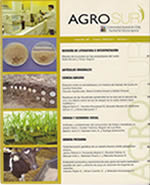Variation of aluminum phytotoxicity in solution of Bromus valdivianus Phil. ecotypes
Main Article Content
Abstract
The objective of this study was to evaluate the response of four ecotypes of Bromus valdivianus Phil. (41, 124, 12 and 58) to increasing levels of aluminum in solution. B. valdivianus ecotypes were previously selected using a solution screening methodology, then Al was applied into a solution in Leonard jars with quartz. Environmental conditions of temperature (20° ± 3°C), relative humidity and photoperiod (16 h light; 8 h darkness) were controlled in the growth chamber. There were six treatments with four replications arranged in a completely random design. The nutrient solution used was renewed daily to maintain a constant pH of 4.2. The aluminum concentrations in solution were: 1.9; 5.7; 17.0; 51.0 and 152.9 mg Al L-1 (applied as aluminum sulfate) and a control, with no application of aluminum. The above ground and root dry matter produced was evaluated separately. To detect differences between treatments (p-value ≤ 0.05) analysis of variance was applied and Duncan test was used for differences of means.
The results showed that Bromus evaluated might present a mechanism of tolerance based on Al-root accumulation, suggested by the higher amount of Aluminum accumulated in their roots rather than the shoot. All the ecotypes evaluated showed a significant loss of dry matter production in the range of 5.7 and 17.0 mg Al-1. The increase in the aluminum concentration in the roots would depend on the tolerance level of the ecotype evaluated, suggesting that before dry matter yield loss there is an accumulation of aluminium in the root in tolerant ecotypes.

